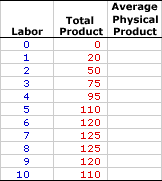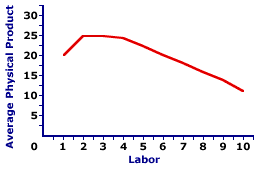
|
|
JOB LEAVERS: Unemployed workers who have voluntarily quit their current jobs and have immediate sought other employment. This is one of the official categories or unemployed workers tracted by the Bureau of Labor Statistics when compiling employment statistics and the unemployment rate. It is also a key to the theoretical notion of frictional unemployment.
Visit the GLOSS*arama
|
|


|

|
                           AVERAGE PHYSICAL PRODUCT: The quantity of total output produced per unit of a variable input, holding all other inputs fixed. Average physical product, usually abbreviated APP, is found by dividing total physical product by the quantity of the variable input. Average product, which more often goes by the shorter name average product (AP), is one of two measures derived from total physical product. The other is marginal physical product. Average physical product is the output produced per unit of input used. Average physical product is more often termed average product. The longer name, created by inserting the word "physical" between "average" and "product," serves to distinguish average PHYSICAL product from average REVENUE product. When no distinction is needed, the simpler term "average product" is suitable. However, when analysis turns to marginal productivity theory and factor markets, a distinction IS important. Conceptually, average physical product is simply the arithmetic mean of total physical product calculated for each variable input over a whole range of variable input quantities. The formula for specifying and calculating average physical product from total physical product is given as: | average physical product | = | total physical product
variable input |
Average Taco ProductionThe table at the right summarizes the hourly production by Waldo's TexMex Taco World of Super Deluxe TexMex Gargantuan Tacos (with sour cream and jalapeno peppers). The total product numbers presented can be used to derive average physical product.| Average Taco Product |  |
The column on the left is the variable input, specifically the number of workers employed by Waldo's TexMex Taco World, which ranges from 0 to 10. The column to the right is the total (physical) product, the total number of TexMex Gargantuan Tacos produced each hour, which ranges from a low of 0 to a high of 125 before declining to 110. Keep in mind that the taco production from these workers depends on a given amount of fixed inputs, Waldo's TexMex Taco World restaurant and all of the capital that goes with it.Missing from this table is any mention of average physical product. This apparent oversight can be fixed with a few button clicks. - First, consider the average physical product for Waldo's TexMex Taco World workforce if Waldo employs only one worker. With one worker, total production is 20 Gargantuan Tacos each hour. Averaging this total production of 20 tacos over the variable input of one worker, gives an average physical product of 20 Gargantuan Tacos. Click the [One] button to display the average physical product for one worker.
- Now consider the average physical product if Waldo's employs two workers. In this case, the total hourly production is 50 Gargantuan Tacos. Dividing 50 tacos by two workers gives an average physical product of 25 Gargantuan Tacos. Click the [Two] button to display the average physical product for two workers.
- Consider one more calculation. If Waldo's employs three workers, the total hourly production increases to 75 Gargantuan Tacos. Dividing 75 tacos by three workers results in an average physical product of 25 Gargantuan Tacos. Click the [Three] button to display the average physical product for three workers.
The remaining average physical product values can be derived in a similar manner. To reveal the entire column of average physical product values, click the [Others] button. Please feel free to spot check the math on a few of these numbers by dividing the total product by the quantity of the variable input.An observation or three about this column of numbers is in order. - First, average physical product increases for the first two workers, reaches a peak of 25 tacos per worker per hour with either two or three workers employed, then declines thereafter.
- Second, this decline in average physical product is indirectly caused by the law of diminishing marginal returns.
- Third, while it might not be obvious from this table, average physical product continues to decline as Waldo's workforce expands, but average physical product is NEVER negative. To have a negative average physical product, total product must be negative, and that just does not make sense.
The Average Physical Product Curve| Average Physical Product Curve |  |
The average physical product curve is a graphical representation of the relation between average physical product and the variable input. The average physical product curve for Gargantuan Taco production is displayed to the right.The "general" slope of this curve is negative, with per unit output lower for larger workforces. However, the average physical product curve is actually "hump" shaped, with a positive slope giving way to a negative slope. Consistent with the numbers in the table, the curve reaches a peak of 25 Gargantuan Tacos at both 2 and 3 workers, before declining. Total and MarginalTwo related product measures are total physical product and average physical product.- Total Physical Product: A longer name for total product, this is the total quantity of output produced by a firm for a given quantity of inputs. Total physical product is the foundation upon which the analysis of short-run production for a firm and marginal productivity theory are based. It also provides the basis for calculating average physical product.
- Marginal Physical Product: This is the change in total physical product resulting from a change in the number of workers. Marginal physical product indicates how the total production of TexMex Gargantuan Tacos changes when an extra worker is hired or fired. For example, hiring a fifth worker means that Waldo's TexMex Taco World total physical product increases from 95 to 110 tacos. The addition of fifth worker results in the production of an additional 15 TexMex Gargantuan Tacos.

Recommended Citation:AVERAGE PHYSICAL PRODUCT, AmosWEB Encyclonomic WEB*pedia, http://www.AmosWEB.com, AmosWEB LLC, 2000-2025. [Accessed: July 1, 2025].
Check Out These Related Terms... | | | | | | | | |
Or For A Little Background... | | | | | | | | | | |
And For Further Study... | | | | | | | | | |
Search Again?
Back to the WEB*pedia
|



|

|
YELLOW CHIPPEROON
[What's This?]
Today, you are likely to spend a great deal of time touring the new suburban shopping complex looking to buy either a how-to book on home decorating or a set of luggage with wheels. Be on the lookout for the happiest person in the room.
Your Complete Scope
This isn't me! What am I?
|

|
|
Paper money used by the Commonwealth of Massachusetts prior to the U.S. Revolutionary War, which was issued against the dictates of Britain, was designed by patriot and silversmith, Paul Revere.
|

|
|
"Experience keeps a dear school, but fools will learn in no other. " -- Benjamin Franklin
|

|
HDI
Human Development Index
|

|
|
Tell us what you think about AmosWEB. Like what you see? Have suggestions for improvements? Let us know. Click the User Feedback link.
User Feedback
|


|


